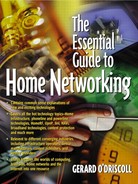BROWSING A UPNP HOME NETWORK
So far in this chapter we have explored the main elements and protocols of the UPnP standard. Now it is time to look at a typical browsing protocol sequence on a UPnP-based home network. The process is illustrated in Figure 13.4.
Basically, the user control point sends an SSDP discovery request to the controlled device on the network and waits for a response in the form of a URL. Once a response has been received, the discovery client software module will then send a HTTP GET command to the discovery server that is located on the controlled device. The server will then respond to the request. The device description service on the user control point will now take over and send a number of GET commands to the description server. The server responds by sending the user control point an icon, a name, and an SCPD. The visual navigation subsystem will then allow a home-networking user to select the device icon on the display system (for instance, a television).
Figure 13.4. UPnP browsing

Visual navigation is term used by the UPnP standard to describe the display of device icons that are connected to a home network. If, for instance, the user control point is running Windows, the visual navigation could be implemented as a folder of icons. The final stages of the process consist of standard HTTP calls to the Web server on the controlled device. The embedded script in the requested Web page displays the device user interface and calls the rehydrator module to interact with the controlled device.
